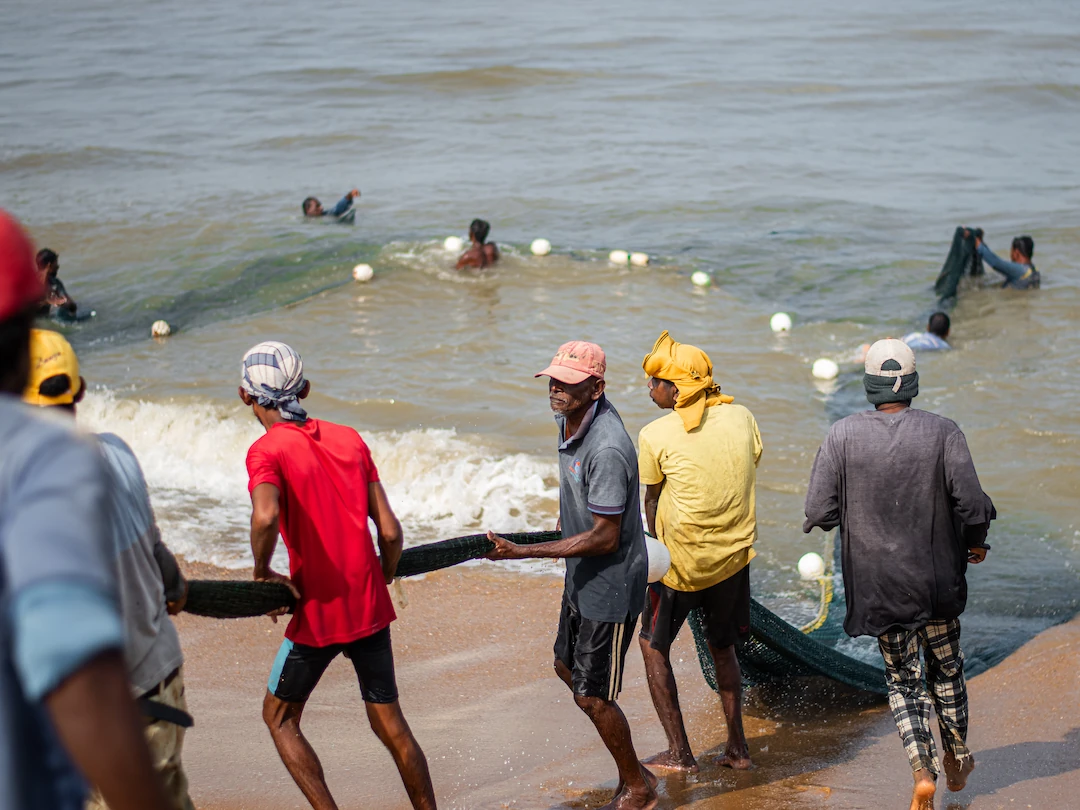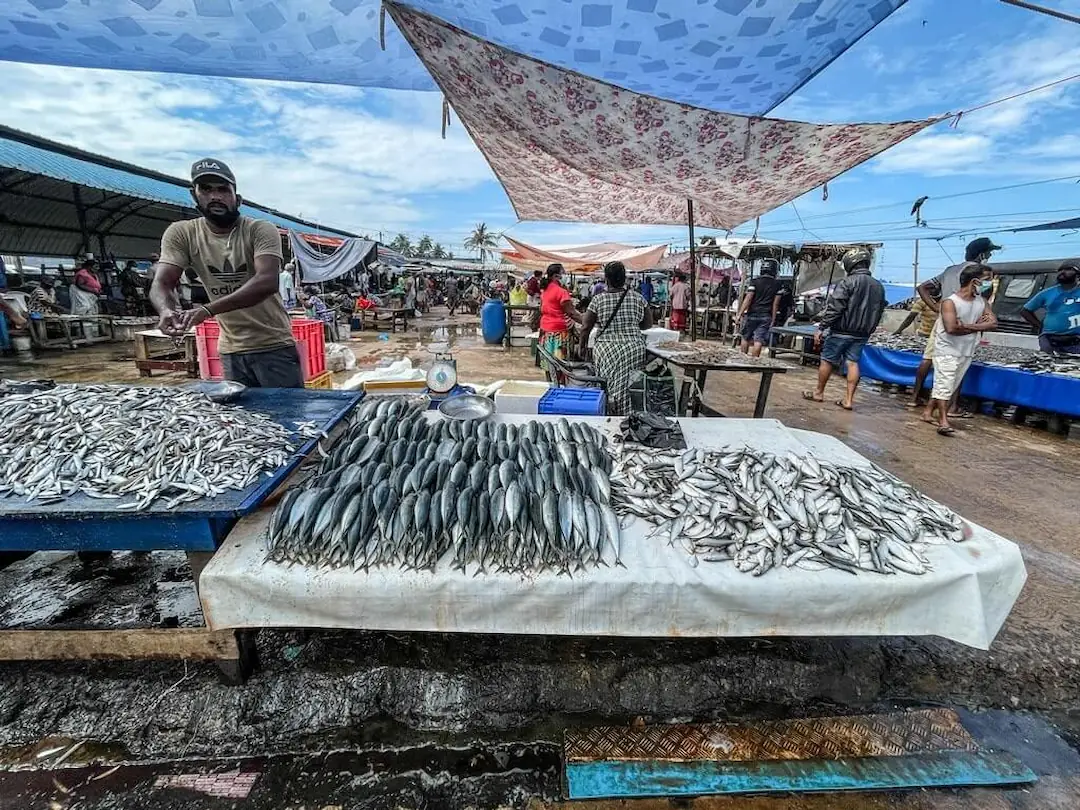The Negombo Fish Market in Sri Lanka isn’t just a place to buy seafood; it’s an experience that you must get at least once in a lifetime. To some people, it’s an adventure that fills their senses with the essence of Sri Lankan life. Especially if you cannot handle strong fish smells, it’ll be an adventure for sure.
All jokes aside, this market offers more than just fresh fish. It’s a lively, chaotic burst of colors, sounds, and smells that feel like stepping into the heart of a fishing village. In my previous Negombo Must-Visit Guide, I briefly mentioned this. Let me tell you more about this amazing place that you must visit when you’re in Negombo.
The Negombo Fish Market people call this place Lellama (pronounced Lel-La-Ma), which is one of the Sri Lanka’s largest fish markets. (It’s technically the second-largest fish market) It’s at the northern end of Negombo Lagoon, visible from Munnakare Bridge. Locals named and run this bustling spot, where you can see fishermen bringing in their daily catches and buyers negotiating prices.
The first time I stumbled upon it was when I was just randomly traveling across Negombo without a proper plan. I was blown away form the experienced fishermen arriving with their catch at the crack of dawn to the locals bargaining over the freshest seafood; the entire place is alive with excitement.
Around 4,000 boats depart from here daily, starting at around 3:30 AM. If you want a true taste of Sri Lankan culture, or you are a die-hard seafood eater the Negombo Fish Market is where you need to be.
A Sri Lankan Coastal Town With Fishing Roots

Photo by Sandaru Muthuwadige
Negombo wasn’t always known for its sandy beaches and bustling resorts. Long before it became a popular getaway for travelers and tourists, it was—and still is—a fishing town at heart. Fishing has been the backbone of Negombo’s economy for generations, providing a livelihood for many local families.
Walking through the market, you can feel that history in every corner. So, personally, I call myself a wanderer. I don’t plan tours, mostly. I love to cycle through Negombo, but when I’m here, I always wonder how many stories this beach can tell about how the lively hood of Sri Lankan culture expands.
Take a minute and think about it. The local life here still circles around the ocean, just as it did centuries ago. Locals head out before dawn, casting their nets with the same skill passed down through the generations.
The market’s location at the northern tip of Negombo Lagoon is more than just convenient; it’s vital. The lagoon is rich in marine life, making it the perfect spot for catching shrimp, crabs, and lobsters. These creatures thrive in the estuarine waters, creating a constant supply of fresh seafood that has supported the community for ages.
Negombo’s position along the coast means larger fish caught in the Indian Ocean are hauled in daily, adding to the market’s variety. Traditional fishing techniques like Kattudel, a method of netting that’s been used for centuries, are still very much alive here.
A Glimpse of Catholic Influence and Architecture
Negombo’s fishing community is deeply rooted in Catholicism, a tradition that dates back to the colonial era. Most of the local fishermen are Catholic. When you walk around Negombo, you’ll sense it, too. Most of these churches, including St. Mary’s Church, are must-visit places when you visit Sri Lanka.
In a previous article, we talked about the legendary painter N.S Godamanna, who did the arts on most of these churches. Negombo itself is often called “Little Rome” because of the sheer number of churches dotting the landscape. The town is home to some of the most beautiful and historic Catholic churches in Sri Lanka.
The easiest way to visit Negombo Fish Market

If you’re planning a visit to the Negombo Fish Market, this part of the article might be helpful to you more than you think. The market opens around 6 AM and stays open until around noon.
But hey, you’re not going there just to buy fish wholesale, right? If you want to see the freshest catch and fishermen unloading their hauls, try to be there between 5 and 6 AM. It’s basically the best time to visit.
But if you’re not much of an early bird, don’t worry. Even by mid-morning, say around 9 to 11 AM, the market is still rushing with locals bargaining over their seafood and vendors organizing their goods. If you can understand their bargaining mechanisms sometimes, they are hilarious. You’ll definitely have a good time.
The market is split into two distinct areas: one for dry fish and the other for fresh seafood. As you arrive, you’ll see the beach lined with large hessian sacks, each filled with thousands of fish carefully sorted by type, size, and shape.
As for getting to the fish market, is very easy. You can hop into a tuk-tuk is the best way but if you have a car or bicycle you can easily travel through Negombo.
The market is centrally located, so it’s hard to miss. Use Google Maps or just ask for help from a local. Most of them can understand English well, and they’re very friendly. You could also read our The Ultimate Transportation Guide to Negombo article for help.
If you are staying at a place like Seahorse Hotel & Spa you can find plenty of guided tours offering a hassle-free experience, complete with pick-up and drop-off services too.
Local tour guides will help you to find great and hidden places that most of the tourists did not visit. Hey, they might even be able to get you into the fish market early and get you good deals on fish, too. So have fun and happy staying in Negombo.
If you’re ever in Sri Lanka, a visit to the Negombo Fish Market (the second-largest fish market in Sri Lanka)is a must. Whether you’re on the hunt for the best fish, want to meet local fishermen, or simply want to soak in the vibrant atmosphere along the shore, this second-largest fish market has it all.
From fresh crabs to dry fish, you’ll find an array of seafood caught right off the boats that line the beach. Whether you’re staying at a nearby hotel or just making a quick trip from Colombo, Negombo offers a unique travel experience that’s full of Sri Lankan charm.
